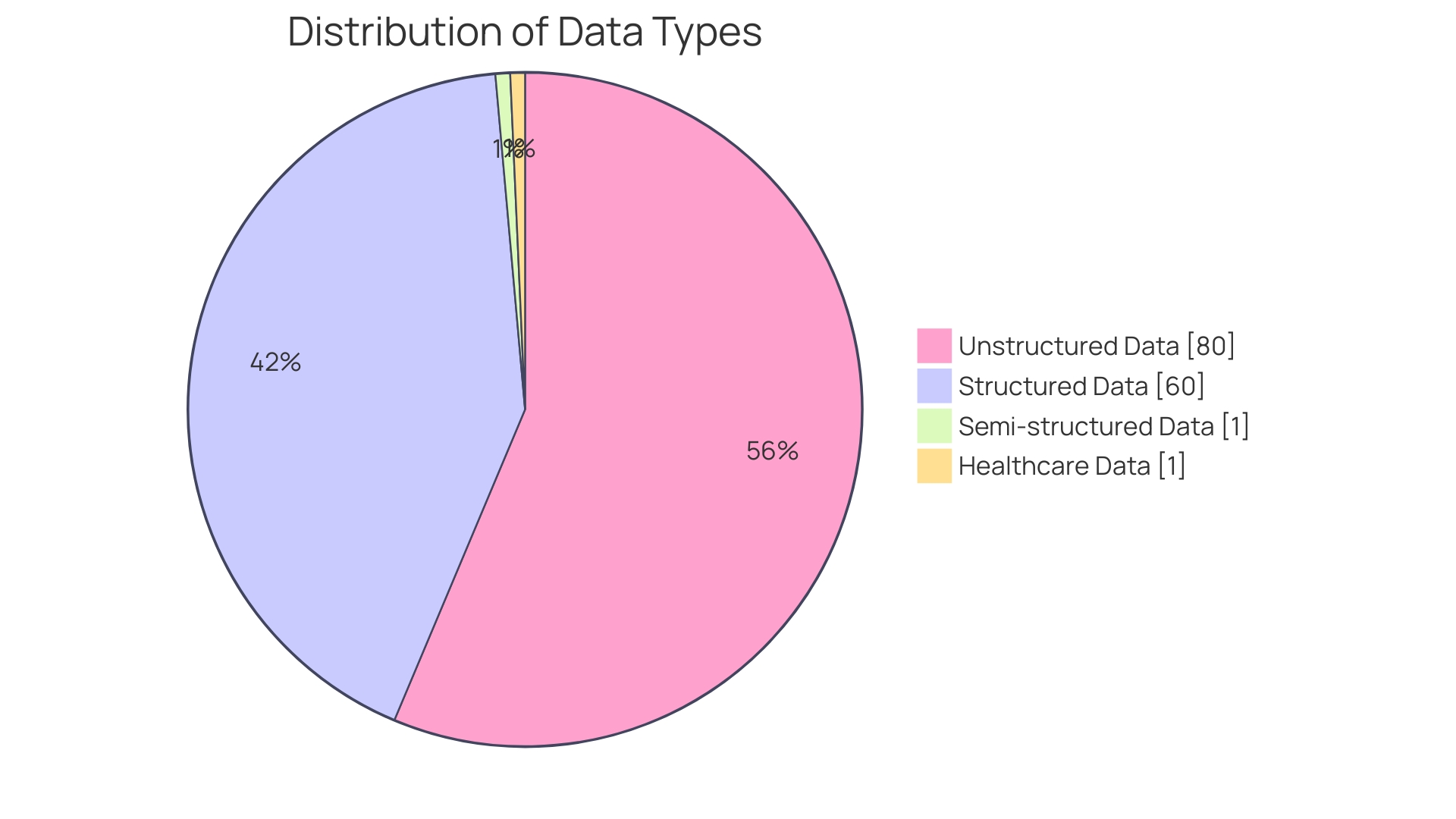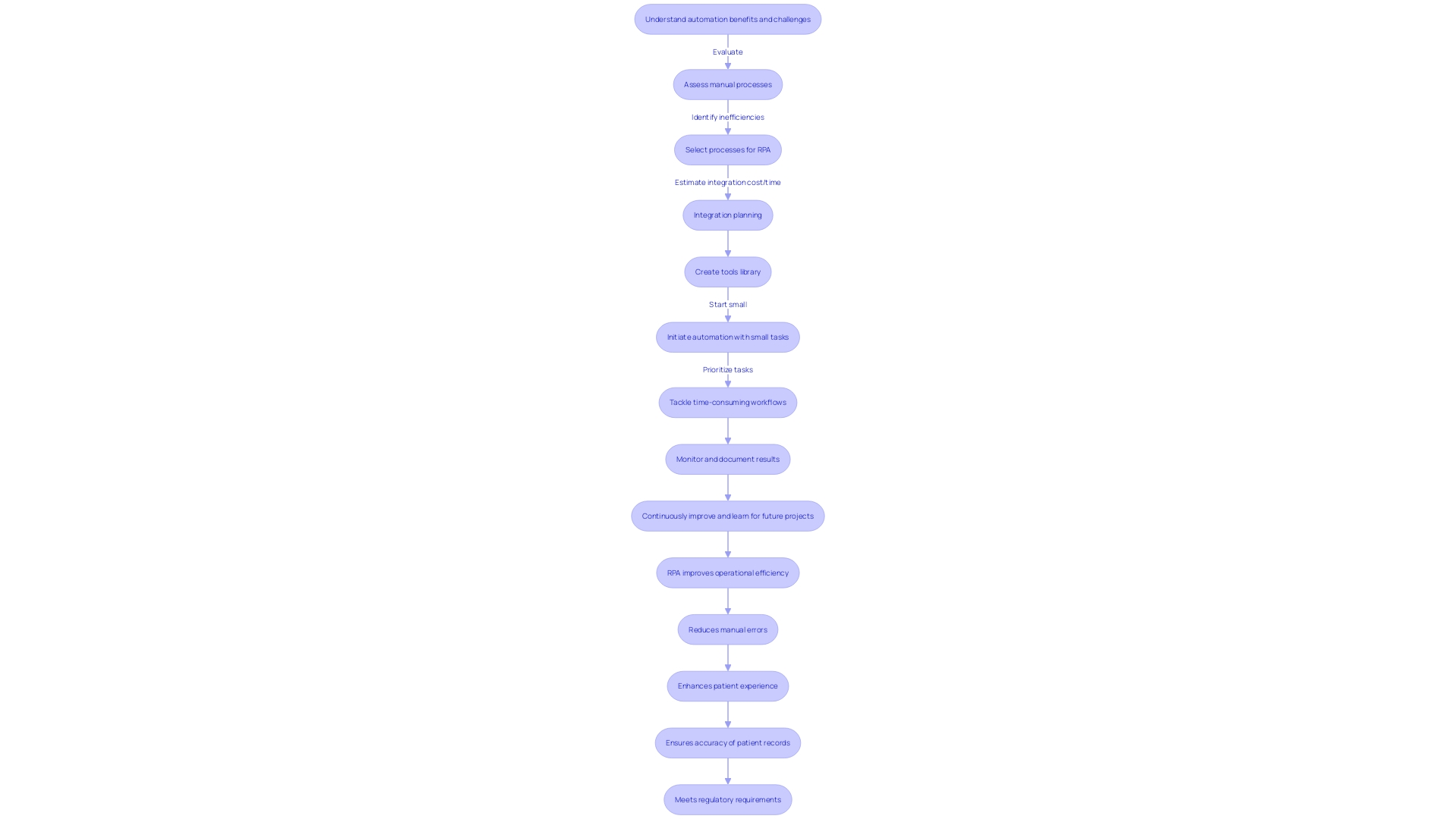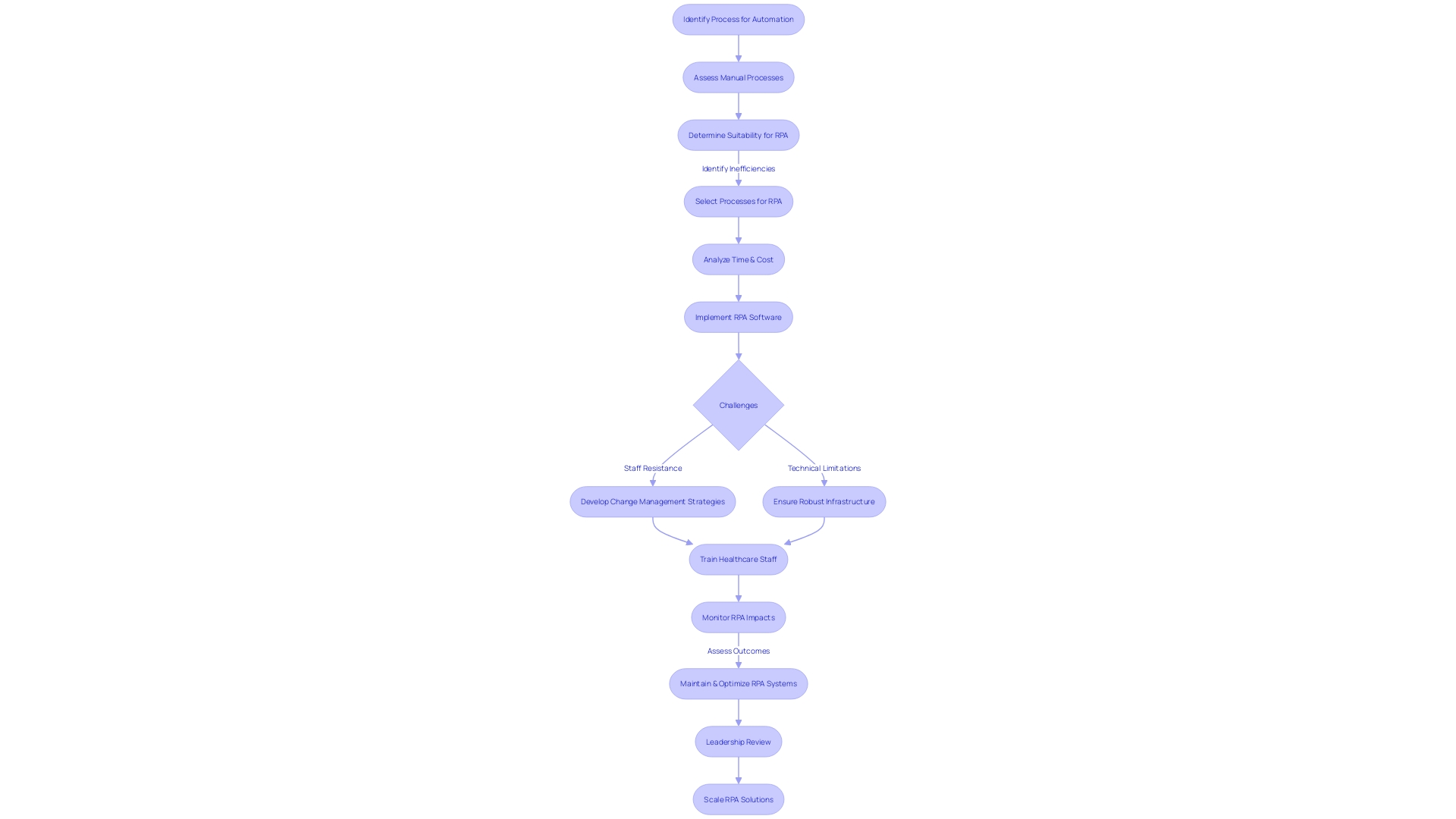Introduction
In the rapidly evolving healthcare industry, the volume of data continues to grow at an unprecedented rate. With the potential to revolutionize patient outcomes and operational efficiency, advanced analytics offers a solution. However, the challenges of managing and utilizing this vast amount of data cannot be ignored.
In this article, we will explore the role of Robotic Process Automation (RPA) in healthcare and how it can transform the industry by automating tasks, streamlining operations, and enhancing patient care. We will also discuss the benefits, implementation strategies, limitations, and the future of RPA in healthcare. By delving into these topics, we will gain valuable insights into the potential of RPA to revolutionize the healthcare industry and shape its future.
Challenges in the Healthcare Industry
As the healthcare industry burgeons with data, advanced analytics offers a means to harness this volume for the betterment of patient outcomes, operational efficiency, and organizational cost-management. The deluge of healthcare data not only includes structured information, such as clinical notes and sensor readings, but also a vast ocean of unstructured data, like X-rays and MRIs, presenting both opportunities and challenges.
With 30% of the world's data stemming from healthcare and an expected growth rate of 36% by 2025, the sheer volume is daunting. Currently, 97% of this massive data remains untapped, according to the World Health Forum, suggesting a critical transition point for medical organizations.
The implications for healthcare providers are immense, offering potential as a new profitable area, especially when considering Ai's contribution. Mayo Clinic, for example, has strategically aligned its renowned medical research with AI development, recognizing its substantial impact on patient care.
Ajai Sehgal, the institution's CDAO, has emphasized the value of enabling AI development over imposing rigid governance, thereby nurturing AI's potential to manage healthcare's complexity including patient records and billing. However, one cannot overlook the intrinsic challenges. Access to and management of unstructured data are key, with interoperability and integration being imperative to address the informational sprawl resulting from mergers and acquisitions. A streamlined approach to data management can mitigate administrative burdens and enhance healthcare delivery, yet requires robust IT solutions adaptable to the diverse sources of information. Finally, with the healthcare organizations' critical responsibility of preserving patient privacy, managing communication overload, and maintaining data security amidst a data surge, the road ahead is complex but navigable with precise strategies centered around the unique pain points of both employees and patients.

What is Robotic Process Automation (RPA)?
Embracing Robotic Process Automation (RPA) can be a transformative step for healthcare institutions. By deploying RPA, mundane tasks such as data entry, comprehensive data processing, and crafting meticulous reports can be delegated to intelligent bots.
These automated software entities are adept at mimicking human interaction with various systems, which streamlines operations, curtails the opportunity for human error and enhances overall efficiency. Moreover, healthcare, with its plethora of administrative functions, stands to benefit significantly from the judicious application of RPA.
Key considerations for healthcare leaders include pinpointing precise manual tasks ripe for automation, discerning current process inefficiencies ripe for improvement through RPA, and a thorough assessment of integration costs and timeframes. This approach ensures a strategic modernization of processes. An illustrative example comes from the NHS Digital Service Team, who rigorously evaluate new tech requests for security and necessity, often discovering existing solutions within the trust—highlighting the critical nature of informed decision-making prior to implementing such innovative technologies.
Role of RPA in Healthcare
Navigating through the digitization of healthcare, Robotic Process Automation (RPA) emerges as a pivotal innovation enhancing operations and patient care. With RPA's ability to mimic actions such as data entry and workflow execution, it streamlines a range of processes from scheduling appointments to processing claims.
Critically, it allows healthcare staff to allocate more time towards patient-centric tasks by automating the mundane. In deploying RPA, a judicious approach must be taken.
It's essential to identify manual processes ripe for automation, assess the inefficiencies they harbor, and evaluate the associated time and cost implications. For instance, RPA's role in managing electronic health records not only ensures data precision but also aligns with the goal of cost-effective healthcare delivery by reducing administrative overhead.
Moreover, RPA´s capacity for connecting disparate systems enables the real-time monitoring and analysis of patient data, which isn't just about identifying existing patterns but also about preempting future health trajectories. As RPA takes hold, healthcare entities witness a paradigm shift whereby the technology acts not as a mere cost-saving tool but as an enabler of improved patient outcomes and operational agility. Such strategic deployment requires careful planning and knowledge. As expressed by a spokesperson within the NHS's Digital Service Team, understanding existing assets and avoiding duplications are first steps toward a successful digital adoption. This overarching strategy ensures that the introduction of RPA into healthcare is both secure and compliant, thus optimizing its influence on transforming healthcare services towards a more efficient and patient-focused future.
Use Cases of RPA in Healthcare
Robotic Process Automation (RPA) is transforming the healthcare industry by automating routine tasks and connecting disparate systems. This novel technology optimizes processes such as claims management, where RPA bots meticulously extract and verify data from diverse sources, simplifying the claims process.
As a result, healthcare providers see quicker claims resolutions and enhanced revenue cycles. Furthermore, RPA also redefines patient experience through intelligent scheduling services.
By managing interactions and automating appointment bookings, RPA reduces manual errors and ensures optimal scheduling efficiency. Leaders in healthcare must weigh the multiple facets of introducing such automation technologies.
Probing which manual tasks are ripe for automation is just the starting point. The next steps involve discerning the weaknesses in current workflows that RPA can rectify and assessing the investment necessary for implementation. This calls for an analytical approach in recognizing pre-existing capabilities and ensuring that new digital solutions align with security and compliance standards. It is this strategic assessment and deployment of RPA that unlocks its full potential to streamline healthcare operations and contribute significantly to modern healthcare delivery.
Benefits of RPA in Healthcare
Robotics Process Automation, commonly known as RPA, is redefining operational efficiency in healthcare. By deploying software bots to emulate human actions across data systems, tasks such as data entry, transaction processing, and patient scheduling are automated, leading to a significant reduction in manual errors.
More than just streamlining procedures, this translates to considerable cost savings and optimizes the utilization of healthcare resources. Enriching the patient experience is another area where RPA shines, as it facilitates quicker service delivery by minimizing wait times and streamlining appointment management.
Further benefits are realized in the maintenance of patient records, where RPA's capability for automated data validation ensures the accuracy and integrity of medical data. This is paramount in an industry where the reliable preservation of sensitive patient information is non-negotiable.
Beyond operational aspects, RPA aids healthcare entities in meeting stringent regulatory requirements. The technology enforces consistent processing standards and vigilantly monitors access to sensitive data, bolstering compliance and safeguarding against breaches. Prior to embracing RPA, healthcare leaders should identify which manual processes could benefit most from automation, considering factors such as existing inefficiencies, as well as the time and cost implications of integrating RPA solutions. This strategic approach, rooted in informed decision-making, sets the stage for a successful digital transformation within the healthcare sector.

Implementation and Integration of RPA in Healthcare
When venturing into Robotic Process Automation (RPA) in healthcare, the roadmap begins not with immediate integration but with a meticulous strategy grounded in comprehension of its merits and constraints. Key to this approach is identifying manual processes ripe for automation. While eyeing simplification, one must weigh up inefficiencies that RPA can address against the investment of time and resources in software integration.
The path forward often entails starting with tasks of lower complexity—opting for a measured scale-up, ensuring digital solutions fit the landscape like a glove. The selection of RPA tools demands due diligence, ensuring compatibility with the organization's objectives, often preceded by a thorough vetting process. As NHS Trust has discovered, unearthing existing technologies through a robust assessment conducted by their Digital Service Team mitigates redundancy and uncovers hidden assets.
A relentless pursuit of optimization prescribes training programs and change management strategies as non-negotiables to facilitate seamless transition. As RPA finds its footing within an organization, consistent oversight is paramount to promptly pinpoint potential improvement opportunities. Thus, the continuous revision of processes and vigilance post-adoption assures RPA's promise is fully realized, bolstering efficiency and enabling a focus on more impactful work.
Challenges and Limitations of RPA in Healthcare
Robotic Process Automation (RPA) in healthcare is a transformative force, yet it comes with its set of challenges that require strategic foresight. Resistance from healthcare staff is one such challenge. Concerns about job security can create barriers to the adoption of automation.
However, with correct change management strategies and transparent communication, these challenges can be overcome, ensuring acceptance and collaboration. Furthermore, RPA systems demand constant upkeep to remain effective in the face of ever-changing healthcare processes and technologies. Regular system updates and continuous refinement are needed to adapt to new requirements.
Identifying the right tasks for automation is also crucial. It's important to discern which manual processes can be automated to address inefficiencies effectively. Basic automations, such as centralizing routine tasks using a shared messaging system, can alleviate the burden of repetitive tasks, making operations more efficient.
Leadership is key in navigating the modernization of healthcare processes. It involves carefully evaluating which manual processes to automate, considering both the time investment and integration costs of RPA software. This thoughtful approach to adopting digital technologies ensures that automation meets the needs of both the healthcare system and its providers.

Future of RPA in Healthcare
Robotic Process Automation (RPA) is reshaping the healthcare industry by enhancing the efficiency of operations and enriching patient care. The synergy between RPA and the power of artificial intelligence (AI) and machine learning (ML) equips bots with vast capabilities, handling complicated tasks with ease.
Future projections show RPA transcending typical administrative duties, poised to penetrate clinical areas where it aids healthcare practitioners in providing patient-centered, superior care. Unleashing RPA's potential begins with meticulous planning.
Leaders must first address which manual processes can be aptly automated and the inherent inefficiencies that RPA could potentially eliminate. Exploring the financial and temporal aspects of integrating RPA technology paves the way for a seamless transition to a more streamlined operation.
Adopting RPA follows a strategic approach. First, a request is made for the desired digital technology, which undergoes a rigorous evaluation to ensure cybersecurity, suitability, and compliance.
It's essential to understand whether the requested technology duplicates existing functionalities—often, solutions are already in place, unknown to those in search of innovations. This modernization of healthcare through RPA steers organizations towards data-driven decisions, optimizing resource allocation and strategic planning. For instance, generative AI tailored for medical compliance is changing the landscape, assisting in navigating complex regulations that, in turn, save invaluable time and resources. Canada's robotics market, which includes sectors like medical service robotics, reflects this trend, highlighting the extensive adoption of robotics in service industries. By tackling smaller tasks first, then scaling to intricate workflows, healthcare institutions are setting the stage for intelligent automation that fosters digital transformation. Continuous monitoring and documentation of these advancements are critical to their success, as they help in achieving goals and gathering insights for future endeavors.
Conclusion
In conclusion, Robotic Process Automation (RPA) has the potential to revolutionize the healthcare industry. By automating tasks and streamlining operations, RPA improves patient outcomes, increases efficiency, and enhances the patient experience.
It addresses the challenges of managing vast healthcare data by deploying intelligent bots to reduce errors and free up time for patient-centric tasks. RPA brings numerous benefits to healthcare, including cost reduction, optimized resource allocation, and improved scheduling efficiency.
It ensures the accuracy and integrity of medical data, aids in regulatory compliance, and enforces consistent processing standards. Implementing RPA requires strategic planning, identifying processes ripe for automation, and considering integration costs.
Although challenges exist, such as staff resistance and maintenance needs, they can be overcome with change management and regular system updates. Looking ahead, RPA is poised for further advancements, integrating with artificial intelligence and machine learning to provide patient-centered care and drive efficiency. In summary, RPA offers transformative opportunities for the healthcare industry. By embracing automation and addressing implementation challenges, healthcare organizations can revolutionize their operations, enhance patient care, and shape a more efficient future.





